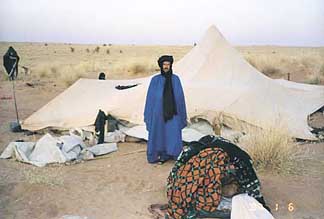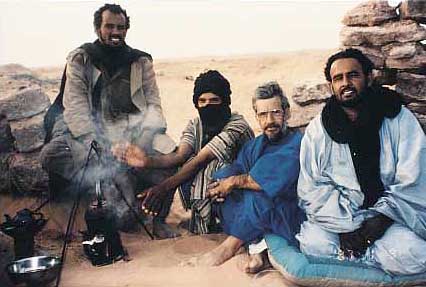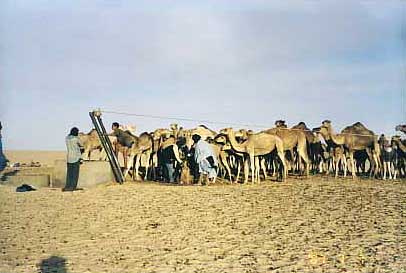Table of Contents
![]() "I
Know I Have Changed": Encounters with Zen in Japan
"I
Know I Have Changed": Encounters with Zen in Japan
By Camelback to Timbuktu
The
Seasons Come and Go:
Impressions of a Peace Corps Tenure in Ghana
Summerterm in
Nepal:
More Than They Bargained for
Learning Outside the Classroom: The FTAA Protests in Quebec City
"Yon ti
dlo fret"
(A Little Cold Water)
By Camelback to Timbuktu
On sabbatical in Spring 2001, Associate Professor of Anthropology John Barthelme attended the Pan-African Archaeological Conference in Mali in February. With time to travel afterwards, he signed on to a working camel caravan scheduled to haul salt slabs from Taoudenni, northern Mali, south across 900 kilometers of Sahara desert and the Sahel ("Sahara" is Arabic for "sand sea," "Sahel" Arabic for "sand sea shore") to Timbuktu, near the Niger River in central Mali. The journey took 21 days, during which Barthelme was able to conduct some archaeological research, learned new ways of living in relation to his environment, and, in his words, "gracefully discovered my own mortality." The pictures and observations here are drawn from his journal of his experiences. --NSB
( 1) In order to reach Taoudenni, Barthelme and several others drove for four days in a four-wheel-drive truck across roadless desert. On the first night, they stayed at the desert home of Dai, a salt merchant who arranged for the caravan and Barthelme's participation in it. The colorful ball in the foreground is cloths and blankets that serve multiple purposes; one of Dai's two wives peeks over the tent to the left. It was here that Barthelme first donned his robe and turban, beheld the majesty of the stars on a silent desert night and had a bowl of camel's milk. "I felt I could hold the constellations in my hands," he says.
(2) At Taoudenni, Barthelme, Dai (right), Dai's brother (left, a salt mine overseer) and a salt miner boil water for tea. "We had three cups of tea six or eight times a day," says Barthelme. "It was bitter, green tea, and the first cup was sugarless, symbolizing death, the second half sugar, symbolizing life, and the third almost all sugar, symbolizing love." Barthelme was told that only half a dozen wazzoons (white people) undertake a caravan ride annually.
(3) Under way: The caravan and several others stop at a well for water. Although famous for their ability to go without water, according to Barthelme camels make "a symphony of noises" in anticipation of getting some--which they do by being persuaded to lower and then raise donkey skin bags. After the first four days, the caravan frequently traveled at night so as to avoid temperatures that reached 120 degrees F--with no shade. "At times I was able to observe half-million-year-old stone tools that the wind had uncovered," Barthelme recalls. He also saw bleached camel bones and several human graves, medical care being unobtainable.


